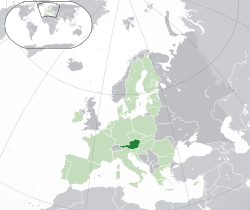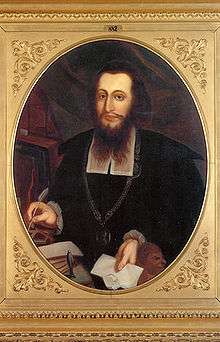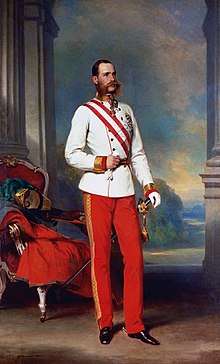History of the Jews in Austria
The history of the Jews in Austria probably begins with the exodus of Jews from Judea under Roman occupation. Over the course of many centuries, the political status of the community rose and fell many times: during certain periods, the Jewish community prospered and enjoyed political equality, and during other periods it suffered pogroms, deportations to concentration camps and mass murder, and antisemitism. The Holocaust drastically reduced the Jewish community in Austria and only 8,140 Jews remained in Austria according to the 2001 census, but other estimates place the current figure at 9,000,[2] 15,000[3] and 20,000 people, if accounting for those of mixed descent.[4]
| Jewish population of Vienna[5][6][7][8] according to census and particular area | |||||||
| Year | total pop. | Jews | % | ||||
|---|---|---|---|---|---|---|---|
| 1857 | 476,220 | 2,617 | 1.3 | ||||
| 1869 | 607,510 | 40,277 | 6.6 | ||||
| 1880 | 726,105 | 73,222 | 10.1 | ||||
| 1890 | 817,300 | 99,444 | 12.1 | ||||
| 1890* | 1,341,190 | 118,495 | 8.8 | ||||
| 1900 | 1,674,957 | 146,926 | 8.7 | ||||
| 1910 | 2,031,420 | 175,294 | 8.6 | ||||
| 1923 | 1,865,780 | 201,513 | 10.8 | ||||
| 1934 | 1,935,881 | 176,034 | 9.1 | ||||
| 1951 | 1,616,125 | 9,000 | 0.6 | ||||
| 1961 | 1,627,566 | 8,354 | 0.5 | ||||
| 1971 | 1,619,855 | 7,747 | 0.5 | ||||
| 1981 | 1,531,346 | 6,527 | 0.4 | ||||
| 1991 | 1,539,848 | 6,554 | 0.4 | ||||
| 2001 | 1,550,123 | 6,988 | 0.5 | ||||
| * = after expansion of Vienna | |||||||
| Total population | |
|---|---|
| 9,000[1] | |
| Regions with significant populations | |
| Languages | |
| German, Yiddish, Hebrew | |
| Religion | |
| Judaism | |
| Related ethnic groups | |
| Other Jews (Ashkenazi, Sephardic, Mizrahi), German Jews, Czech Jews, Polish Jews, Hungarian Jews, Russian Jews, Ukrainian Jews |
Part of a series on the |
|---|
| History of Austria |
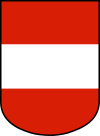 |
|
Early history
|
|
World War I
|
|
World War II
|
|
Post-war Austria |
|
Topics |
|
|
Antiquity
Jews have been in Austria since at least the 3rd century AD. In 2008 a team of archeologists discovered a third-century CE amulet in the form of a gold scroll with the words of the Jewish prayer Shema Yisrael (Hear, O Israel! The Lord is our God, the Lord is one) inscribed on it in the grave of a Jewish infant in Halbturn. It is considered to be the earliest surviving evidence of a Jewish presence in what is now Austria.[9] It is hypothesized that the first Jews immigrated to Austria following the Roman legions after the Roman occupation of Israel. It is theorized that the Roman legions who participated in the occupation and came back after the First Jewish–Roman War brought back Jewish prisoners.[10]
The Middle Ages
A document from the 10th century that determined equal rights between the Jewish and Christian merchants in Danube implies a Jewish population in Vienna at this point, though again, there is no concrete proof. The existence of a Jewish community in the area is only known for sure after the start of the 12th century, when two synagogues existed. In the same century, the Jewish settlement in Vienna increased with the absorption of Jewish settlers from Bavaria and from the Rhineland.
At the start of the 13th century, the Jewish community began to flourish. One of the main reasons for the prosperity was the declaration by Frederick II that the Jews were a separate ethnic and religious group, and were not bound to the laws that targeted the Christian population. Following this assumption, in July 1244, the emperor published a bill of rights for Jews, which barred them from many jobs, businesses and educational opportunities, but allowed for rights to sales, thus encouraging them to work in the money lending business, encouraged the immigration of additional Jews to the area, and promised protection and autonomous rights, such as the right to judge themselves and the right to collect taxes. This bill of rights affected other kingdoms in Europe such as Hungary, Poland, Lithuania, Silesia and Bohemia, which had a high concentrations of Jews.
During this period, the Jewish population mainly dealt with commerce and the collection of taxes and also gained key positions in many other aspects of life in Austria. In 1204, the first documented synagogue in Austria was constructed. In addition, Jews went through a period of religious freedom and relative prosperity; a group of families headed by notable rabbis settled in Vienna — these learned men were later referred to as "the wise men of Vienna". The group established a beit midrash that was considered to be the most prominent school of Talmudic studies in Europe at the time.
The insularity and assumed prosperity of the Jewish community caused increased tensions and jealousy from the Christian population along with hostility from the church. In 1282, when the area became controlled by the Catholic House of Habsburg, Austria's prominence decreased as far as being a religious center for Jewish scholarly endeavors due to the highly anti-Semitic atmosphere.
Some Jewish business enterprises focused on civic finance, private interest-free loans and government accounting work enforcing tax collection and handling moneylending for Christian landowners. The earliest evidence of Jewish officials tasked with the unpleasant role of collecting unpaid taxes appears in a document from 1320. During the same time, riots occurred scapegoating all Jews who resided in the area. The entire Jewish population was unfairly targeted by some angry non-Jewish neighbors and the animosity made daily life unbearable — the population continued to decline in middle of the 14th century. At the start of the 15th century, during the regime of Albert III and Leopold III, the period was characterized by the formal cancellations of many outstanding debts that were owed to Jewish financiers, and those that would have been enforced by debt collection activity by Jews were left purposely outstanding so as to impoverish the jewish creditor; there were then mass official confiscation of all Jewish assets, and the creation of policies demanding economic limitations against all Jewish people.
Deportation from Austria
In middle of the 15th century, following the establishment of the anti-Catholic movement of Jan Hus in Bohemia, the condition of Jews worsened as a result of unfounded accusations that the movement was associated with the Jewish community.
In 1420, the status of the Jewish community hit a low point when a Jewish man from Upper Austria was falsely accused and charged with the crime of desecration of the sacramental bread. This led Albert V to order the imprisonment of all of Jews in Austria. 210 Jewish men, women and children were forcibly taken from their homes and were burnt alive in the public town square, while the remaining families were rounded up and deported from Austria, forced to leave all their belongings behind. In 1469, the deportation order was cancelled by Frederick III, who became known for his fairness and strong relationship by allowing Jews to live relatively free from scapegoating and hate-crimes — he was even referred to at times as the "King of the Jews". He allowed Jews to return and settle in all the cities of Styria and Carinthia. Under his regime, Jews gained a short period of peace (between 1440 and 1493).
In 1496, Maximilian I ordered a decree which expelled all Jews from Styria.[11] In 1509, he passed the "Imperial Confiscation Mandate" which foresaw the destruction of all Jewish books, apart from one exception, the Bible.[12]
The rise of religious fanaticism of the Society of Jesus
The relative period of peace did not last long, and with the start of the regime of Ferdinand the First in 1556, though he also opposed the persecution of the Jews, he levied excessive taxes and ordered them to wear a mark of disgrace. Between 1564 and 1619, in the period of the reigns of Maximilian the second, Rudolf the Second and Matthias, the fanaticism of the Society of Jesus prevailed and the condition of the Jews worsened even more. Later on, during the reign of Ferdinand the Second in Austria, which in spite of that like his grandfather he opposed the persecution of the Jews and even permitted constructing a synagogue, he demanded a huge amount of tax from the Jewish population.
The nadir of the Jewish community in Austria arrived during the period of the reign of Leopold the First, a period in which Jews were persecuted frequently and were deported from different areas, including a deportation from Vienna in 1670, but gradually returned after several years. Jews also had to bear different laws—one of which permitted only first-born children to marry, in order to stop the increase of the Jewish population. Although Leopold the First treated the Jewish population severely, he had Samson Wertheimer, a Jewish economic advisor, working for him.
A Sabbateans movement, which was established during the same period of time, also reached the Jewish community in Austria, especially due to the rough condition of the Jews there, and many of them immigrated to the land of Israel in the footsteps of Sabbatai Zevi.
Modern period
Change in the attitude towards the Jews
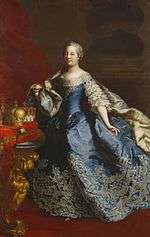
After the period of the religious fanaticism towards the Jewish population of the region, a period of relative tolerance began which was less noticeable during the reign of Maria Theresa of Austria. It reached its peak during the reign of Franz Joseph I of Austria, who was very popular among the Jewish population.
Upon the partition of the Polish-Lithuanian Commonwealth in 1772, the Kingdom of Galicia and Lodomeria, or simply "Galicia", became the largest, most populous, and northernmost province of the Austrian Empire. As a result of annexation, many Jews were added to the Austrian Empire and the empress, Maria Theresa, quickly legislated different laws aimed at regulating their rights and canceled Jewish autonomy to take authority over the Jews.
Although the empress was known for her hatred of Jews, several Jews did work for her at her court. The empress made it mandatory that Jews would go to the general elementary schools, and in addition permitted them to join universities. Jewish schools did not exist yet during that time.
After Maria Theresa's death in 1780, her son Joseph II succeeded her and started working on the integration of Jews into Austrian society. The emperor determined that they would be obligated to enlist to the army, and established governmental schools for Jews. The 1782 Edict of Tolerance canceled different limitations that had been placed upon Jews previously, such as the restriction to live only in predetermined locations and the limitation to certain professions. They were now allowed to establish factories, hire Christian servants and study at higher education institutions, but all this only on the condition that Jews would be obligated to attend school, that they would use German only in the official documents instead of Hebrew or Yiddish, that dorsal tax would be forbidden, that the trials held within the community would be condensed, and that those who would not get an education would not be able to marry before the age of 25. The emperor also declared that Jews would establish Jewish schools for their children, but they opposed that because he forbade them organizing within the community and establishing public institutions. In the aftermath of different resistances, also from the Jewish party, which opposed the many conditions held upon them, and also from the Christian party, which opposed many of the rights given to Jews, the decree was not fully implemented.
Upon his death in 1790, Joseph II was succeeded by his brother, Leopold II. After only two years of his reign, he died and was succeeded by his son Francis II, who continued working on the integration of Jews into the wider Austrian society, but he was more moderate than his uncle. In 1812, a Jewish Sunday school was opened in Vienna. During the same period of time a number of limitations were placed on Jews, such as the obligation to study in Christian schools and to pray in German.
Prosperity
Between 1848 and 1938, Jews in Austria enjoyed a period of prosperity beginning with the start of the reign of Franz Joseph I as the Emperor of the Austria–Hungary Empire, and dissolved gradually after the death of the emperor to the annexation of Austria to Germany by the Nazis, a process that led to the start of the Holocaust in Austria.
Franz Joseph I granted Jews equal rights, saying "the civil rights and the country's policy is not contingent in the people's religion". The emperor was well liked by Jews, which, as a token of appreciation, wrote prayers and songs about him that were printed in Jewish prayer books. In 1849 the emperor canceled the prohibition against Jews organizing within the community, and in 1852 new regulations of the Jewish community were set. In 1867, Jews formally received full equal rights.
In 1869 the emperor visited Jerusalem and was greeted with great admiration by Jews there. The emperor established a fund aimed at financing the establishment of Jewish institutions and in addition established the Talmudic school for rabbis in Budapest. During the 1890s several Jews were elected to the Austrian parliament.
During the reign of Franz Joseph and after, Austria's Jewish population contributed greatly to Austrian culture despite their small percentage in the population. Contributions came from Jewish lawyers, journalists (among them Theodor Herzl), authors, playwrights, poets, doctors, bankers, businessmen and artists. Vienna became a cultural Jewish center, and became a center of education, culture and Zionism. Theodor Herzl, the father of Zionism, studied in the University of Vienna, and was the editor of the feuilleton of the Neue Freie Presse, a very influential newspaper at that time. Another Jew, Felix Salten, succeeded Herzl as the editor of the feuilleton.

Other notable influential Jews contributing greatly to Austrian culture included composers Gustav Mahler, Arnold Schoenberg, and the authors Stefan Zweig, Arthur Schnitzler, Karl Kraus, Elias Canetti, Joseph Roth, Vicki Baum and the doctors Sigmund Freud, Viktor Frankl and Alfred Adler, the philosophers Martin Buber, Karl Popper, and many others.
The prosperity period also affected the sports field: the Jewish sports club Hakoah Vienna was established in 1909 and excelled in football, swimming and athletics.
With Jewish prosperity and equality, several Jewish scholars converted to Christianity in a desire to assimilate into Austrian society. Among them were Karl Kraus and Otto Weininger.
During this period, Vienna elected an antisemitic mayor, Karl Lueger. The emperor, Franz Joseph, was opposed to the appointment, but after Lueger was elected three consecutive times, the emperor was compelled to accept his election according to the regulations. During the period of his authority Lueger removed Jews from positions in the city administration and forbade them from working in the factories located in Vienna until his death in 1910.
The intertwining of Jews and the attitude of the emperor towards them could also be seen in the general state of the empire. From the middle of the 19th century there started to be many pressures from the different nationalities living in the multinational House of Habsburg empire: the national minorities (such as the Hungarians, Czechs and Croatians) began demanding more and more collective rights; among German speakers, many started feeling more connected to Germany, which was strengthening. Under these circumstances, the Jewish population was especially notable for their loyalty to the empire and their admiration of the emperor.
In about 1918, there were about 300,000 Jews in Austria scattered in 33 different settlements. Most of them (about 200,000) lived in Vienna.
The First Republic and Austrofascism (1918–1934 / 1934–1938)
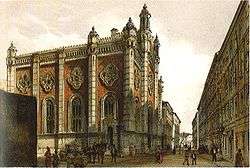
Austria during the First Republic (1919–34) was strongly influenced by Jews. Many of the leading heads of the Social Democratic Party of Austria and especially the leaders of the Austromarxism were assimilated Jews, for example Victor Adler, Otto Bauer, Gustav Eckstein, Julius Deutsch and also the reformer of the school system in Vienna, Hugo Breitner. Due to the Social Democratic Party being the only party in Austria that accepted Jews as members and also in leading positions, several Jewish parties that were founded after 1918 in Vienna, where about 10% of the population was Jewish, had no chance for gaining bigger parts of the Jewish population. Districts with high Jewish population rates, such as Leopoldstadt, the only districts where Jews formed about the half of the population, and the neighbouring districts Alsergrund and Brigittenau, where up to a third of the population was Jewish, had usually higher percentage rates of voters for the Social Democratic Party than classical "worker"-districts.[13]
In May 1923, Vienna hosted the First World Congress of Jewish Women in the presence of President Michael Hainisch, calling in particular for support for the relocation of Jewish refugees in Palestine.[14]
Also the cultural contribution of Jews reached its peak. Many famous writers, film and theatre directors (for example Max Reinhardt, Fritz Lang, Richard Oswald, Fred Zinnemann and Otto Preminger) actors (i.e. Peter Lorre, Paul Muni) and producers (i.e. Jacob Fleck, Oscar Pilzer, Arnold Pressburger), architects and set designers (i.e. Artur Berger, Harry Horner, Oskar Strnad, Ernst Deutsch-Dryden), comedians (Kabarett artists, for example: Heinrich Eisenbach, Fritz Grünbaum, Karl Farkas, Georg Kreisler, Hermann Leopoldi, Armin Berg), musicians and composers (i.e. Fritz Kreisler, Hans J. Salter, Erich Wolfgang Korngold, Max Steiner) were Jewish Austrians. In 1933, many Austrian Jews, who had worked and lived in Germany for years, returned to Austria, including many who fled Nazi restrictions on Jews working in the film industry.
In 1934, the Austrian Civil War broke out. The new regime was fascist, and leaders of the Social Democratic Party were arrested or had to flee. But, except for Jews strongly engaged in the Social Democratic Party, the regime, which thought itself as pro-Austrian and anti-national socialism, brought no worsening for the Jewish population.
The census of 1934[15] counted 191,481 Jews in Austria, with 176,034 living in Vienna and most of the rest in Lower Austria (7,716) and Burgenland (3,632), where notable Jewish communities also existed. Of the other Bundesländer, only Styria (2,195) also counted more than 1,000 Jews. The United States Holocaust Memorial Museum estimates 250,000 Jews in Austria in 1933.[16]
In 1936, the previously strong Austrian film industry, which had developed its own "emigrant-film"-movement, had to accept the German restrictions forbidding Jews from working in the film industry. Emigration among film artists then rose sharply with Los Angeles becoming the major destination. The main emigration wave started in March 1938, with Anschluss, to November 1938, when nearly all synagogues in Austria were destroyed (more than 100, about 30 to 40 of which were built as dedicated synagogues, 25 of them in Vienna).
Anschluss

The prosperity ended abruptly on 13 March 1938 with the annexation of Austria by Nazi Germany (the "Anschluss"). The Jewish population in Austria at the time was 181,882, with 167,249 in Vienna. Thousands of Jews had already emigrated before Anschluss. The German racial Nuremberg Laws were immediately applied to Austria, so that people with one Jewish grandparent were deemed to be Jewish, even if they or their parents had converted to another faith, so that 201,000 to 214,000 people were caught by these anti-Jewish laws.[15]
The Nazis entered Austria without any major resistance, and were accepted approvingly by many Austrians.[17] Immediately after Anschluss, the Nazis started instituting anti-Jewish measures throughout the country. Jews were expelled from all cultural, economic and social life in Austria. Jewish businesses were ‘aryanised’ and either sold for a fraction of their value or seized outright. Jewish citizens were humiliated as they were commanded to perform different menial tasks, without any consideration of age, social position or sex.
On November 9th, "the Night of Broken Glass" (Kristallnacht) was carried out in Germany and Austria. Synagogues all over Austria were looted and burned by the Hitler Youth and the SA. Jewish shops were vandalised and looted and some Jewish homes were destroyed. During that night, 27 Jews were murdered, and many others beaten.
The Holocaust in Austria
After the Anschluss, all Jews were effectively forced to emigrate from Austria, but the process was made extremely difficult. The emigration center was in Vienna, and the people leaving were required to have numerous documents approving their departure from different departments. They were not allowed to take cash or stocks or valuable items like jewellery or gold, and most antiques or artworks were declared ‘important to the state’ and could not be exported, and were often simply seized; essentially only clothes and household items could be taken, so nearly everything of value was left behind. To leave the country, a departure ‘tax’ had to be paid, which was a large percentage of their entire property. Emigrants hurried to collect only their most important personal belongings, pay the departure fees, and had to leave behind them everything else. Departure was only possible with a visa to enter another country, which was hard to obtain, especially for the poor and elderly, so even the wealthy sometimes had to leave behind their parents or grandparents. The last Jews left legally in 1941. Almost all Jews who remained after this time were murdered in the Holocaust.
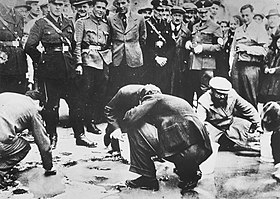
Some foreign officials assisted by issuing far more visas than they were officially allowed to. The Chinese consul to Austria Feng-Shan Ho, risking his own life and his career, with the aid of his Catholic Viennese staff, rapidly approved the visa applications of thousands of Jews seeking to escape the Nazis. Among them were possibly the Austrian filmmakers Jacob and Luise Fleck, who got one of the last visas for China in 1940 and who then produced films with Chinese filmmakers in Shanghai. Ho's actions were recognized posthumously when he was awarded the title Righteous among the Nations by the Israeli organization Yad Vashem in 2001.
Mrs. Wijsmuller
In December 1938 the Dutch representative of a committee for aid to Jews, Mrs. Geertruida Wijsmuller-Meijer, went to Vienna after being requested to do so by the British (and Jewish) professor Norman Bentwich, who on behalf of the British government sought help to fulfill the quota of 10,000 temporary Jewish refugee children from nazi-Germany and Naza-Austria. Mrs Wijsmuller went to Vienna but was arrested for critisizing the Nazi 'Wibnterhilfe-colection, but managed to talk her way out and the next day headed straight to the then office of Adolf Eichmann, the then relatively unknown head of the Central for Jewish Emigration Zentralstelle für jüdische Auswanderung. At first, he refused to see her, but then let her in for five minutes and disapprovingly told her she could take 600 Jewish children if she managed to get them out within one week. She managed. She then kept on organising tranport of children from Germany and Austria. This lasted until the outbreak of WW-II on Sept. 1st, 1939, when European borders were closed. The exact number of Austrian children that could flee through Mrs Wijsmuller's organisation is not exactly known but according to het biographer runs up to 10,000. She does have a memorial room in the Urania center in Vienna.[18] The last transport - now known under the name Kindertransport was on the 14th of May, 1940, three days after The Netherlands was invaded by the Nazis, on the last ship leaving Dutch waters, the SS Bodegraven, on which she managed to place 74 German and Austrian Jewish children. She decided to remain in Holland herself, although she had had the chance of joining the group of children. All of the children she rescued, survived the war circumstances. Mrs Wijsmuller was awarded the title 'Righteous Among the Peoples' by Yad Vashem. Early in 2020 a statue was made in her honour in her birth town of Alkmaar but the erection and unveiling was postponed due to the coronavirus pandemic.
Annihilation
In 1939 the Nazis initiated the annihilation of the Jewish population. The most notable persons of the community, about 6,000, were sent to the Dachau and Buchenwald concentration camps. The main concentration camp in Austria was the Mauthausen Concentration Camp, which was located next to the city of Linz. Many other Jews were sent to the concentration camp of Theresienstadt and the Łódź ghetto in Poland and from there they were transported to the Auschwitz concentration camp. In the summer of 1939 hundreds of factories and Jewish stores were shut down by the government. In October 1941 Jews were forbidden to exit the boundaries of Austria. The total number of Jews who managed to exit Austria is about 28,000. Part of the Vienna Jews was sent to the transit camp at Nisko in Nazi-occupied Poland. At the end of the winter of 1941, an additional 4,500 Jews were sent from Vienna to different concentration and extermination camps in Nazi-occupied Poland (mainly Izbica Kujawska and to ghettos in the Lublin area). In June 1942, a transport went directly from Vienna to Sobibor extermination camp, which had around one thousand Jews. In the fall of 1942, the Nazis sent more Jews to the ghettos in the cities they occupied in the Soviet Union: Riga, Kaunas, Vilnius and Minsk. Those Jews were murdered by the Lithuanian, Latvian and Bielorussian collaborators under the supervision of German soldiers, mainly by being shot in forests and buried in mass graves.
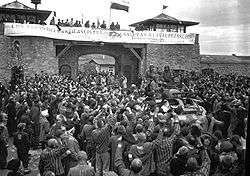
By October 1942 Austria had only about 2,000 to 5,000 Jews left.[19] About 1,900 of these were sent out of the country during the next two years, and the rest remained in hiding. The total number of the Austrian Jewish population murdered during the Holocaust is about 65,500 people, 62,000 of them known by name.[19] The rest of the Jewish population of Austria, excluding up to 5,000 who managed to survive in Austria, emigrated — about 135,000 people of Jewish religion or Jewish ancestry, compared to the number in 1938. But thousands of Austrian Jews emigrated before 1938.
After Second World War
After the Holocaust, the Jews throughout Europe who managed to survive were concentrated in DP camps in Austria. Holocaust survivors who had nowhere to return to after the war remained in the DP camps, and were helped by groups of volunteers who came from Palestine. Until 1955, about 250,000 to 300,000 "displaced persons" lived in Austria. About 3,000 of them stayed in Austria and formed the new Jewish community. Many of the Jews in the DP camps throughout Europe eventually immigrated to Israel. Many others returned to Germany and Austria. In October 2000 the Judenplatz Holocaust Memorial was built in Vienna in memory of the Austrian Jews who were murdered in the Holocaust.
One of the notable prisoners of the Mauthausen concentration camp was Simon Wiesenthal, who after his release worked together with the United States army to locate Nazi war criminals.
During the Hungarian Revolution of 1956 about 200,000 Hungarians fled through Austria to the west, among them 17,000 Jews. Seventy-thousand Hungarians stayed in Austria, a number of Jews among them. One of the best known of them is the political scientist and publicist Paul Lendvai.
Details of the property seized under the Nazis in Vienna from Austrian Jews such as Samuel Schallinger who co-owned the Imperial and the Bristol hotels,[20] and the names of those who took them and never gave them back, are detailed in the book Unser Wien (Our Vienna) by Stephan Templ and Tina Walzer.[21]
Contemporary situation
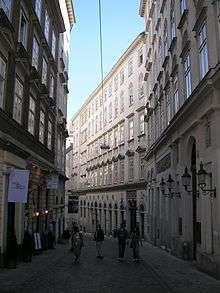
Since the Holocaust, the Jewish community in Austria was rebuilt itself, although it was much smaller. In the 1950s a wave of immigration from the Soviet Union brought Russian Jews to Austria. Since the fall of the Iron Curtain, there has been a renewed influx of Jewish people from the former Soviet Union. The current Austrian Jewish population is around 12,000–15,000 — most living in Vienna, Graz and Salzburg. About 800 are Holocaust survivors who lived in Austria before 1938 and about 1,500 are immigrants from countries once a part of the Soviet Union.
In July 1991 the Austrian government acknowledged its role in the crimes of the Third Reich during World War II. In 1993, the Austrian government reconstructed the Jewish synagogue in Innsbruck, which was destroyed during Kristallnacht, and in 1994 they reconstructed the Jewish library in Vienna, which was then reopened.
Neo-Nazism and antisemitism has not vanished entirely from public life in Austria. In the 1990s many threatening letters were sent to politicians and reporters, and some Austrian public figures have occasionally shown sympathy toward Nazism.
Kurt Waldheim was appointed as Austria's president in 1986 despite having served as an officer in the Wehrmacht during the Second World War. He remained the president of Austria until 1992. During his term he was considered a persona non grata in many countries. From 1989-1991 and 1999–2008, Jörg Haider, who made multiple anti-Semitic statements and was often accused of being a Nazi sympathizer, served as Governor of Carinthia.[22]
The Austrian government was sued for Austria's involvement in the Holocaust and required to compensate its Jewish survivors. Initially, the government postponed the compensation matters, until the United States started putting on pressure. In 1998 the Austrian government introduced the Art Restitution Act, which looked again at the question of art stolen by the Nazis. (But see also, Portrait of Adele Bloch-Bauer I for an example of its reluctance in compensating victims.) In November 2005, the Austrian government sent out compensation letters to the 19,300 Austrian Holocaust survivors still living. The total amount that Austria paid in compensation was over $2 million, which was paid to individual Holocaust survivors themselves, to the owners of businesses that were damaged, and for stolen bank accounts, etc. In addition, the Austrian government also transferred $40 million to the Austria Jewish fund.
The biggest Jewish presence in Austria today is in Vienna, where there are synagogues, a Jewish retirement home, the Jewish Museum (founded in 1993), and other community institutions. Austrian Jews are of many different denominations, from Haredi to Reform Jews. The Jewish community also has many activities arranged by the Chabad movement, which manages kindergartens, schools, a community center and even a university. There are also active branches of Bnei Akiva and Hashomer Hatzair youth movements. Today, the biggest minority among the Jewish community in Vienna are immigrants from Georgia, followed by those from Bukhara, each with separate synagogues and a large community center called "The Spanish center".
There were very few Jews in Austria in the early post-war years; however, some of them became very prominent in Austrian society. These include Bruno Kreisky, who was the Chancellor of Austria between 1970 and 1983, the artist and architect Friedensreich Hundertwasser and Jewish politicians such as Elisabeth Pittermann, a member of the Parliament of Austria from the Social Democratic Party of Austria and Peter Sichrovsky, who was formerly a member of the Freedom Party of Austria and a representative in the European Parliament.
Latent antisemitism is an issue in several rural areas of the country. Some issues in the holiday resort Serfaus gained special attention in 2010, where people thought to be Jews were barred from making hotel bookings, based on a racial bias. Hostility by some inhabitants of the village towards those who accommodate Jews was reported. Several hotels and apartments in the town confirmed that Jews are banned from the premises. Those who book rooms are subjected to racial profiling, and rooms are denied to those who are identified as possible Orthodox Jews.[23]
References
- "Jewish Population of the World". Jewish Virtual Library. 2012. Retrieved 18 December 2013.
- AMERICAN JEWISH YEAR BOOK, 2005
- Ariel Muzicant: Österreich ist anders. May 12, 2005. First published in: Der Standard, May 4, 2005
- Marijana Milijković: Von einer Blüte ist keine Rede – Dennoch tut sich was in der jüdischen Gemeinde: Der Campus im Prater eröffnet. Der Standard, September 12, 2008, page 2
- census 1890, 1900, 1910 of the K. K. Statistischen Central-Kommission and census 1934 and Statistisches Jahrbuch der Stadt Wien für das Jahr 1910, in: Anson Rabinbach: The Migration of Galician Jews to Vienna. Austrian History Yearbook, Volume XI, Berghahn Books/Rice University Press, Houston 1975, S. 48
- Statistisches Jahrbuch der Stadt Wien 1930–1935 (Neue Folge. 3. Band) published by Magistratsabteilung für Statistik. Contains figures of 1910, 1923 und 1934.
- Österreichische Historikerkommission: Schlussbericht der Historikerkommission der Republik Österreich. Band 1. Oldenbourg Verlag, Wien 2003, S. 85–87 (Ergebnis der Volkszählung 1934)
- Statistik Austria: Bevölkerung nach dem Religionsbekenntnis und Bundesländern 1951 bis 2001 (accessed 15 January 2009)
- Archaeological sensation in Austria. Scientists from the University of Vienna unearth the earliest evidence of Jewish inhabitants in Austria, 13.03.08, [tt_news]=5294&tx_ttnews[backPid]=6093&cHash=da0d1160e1 "Archived copy". Archived from the original on 2011-05-31. Retrieved 2009-03-02.CS1 maint: archived copy as title (link)
- Uni, Assaf (2008-04-02). "3rd century amulet - sign of earliest Jewish life in Austria - Haaretz Daily Newspaper | Israel News". Haaretz.com. Archived from the original on 2008-03-24. Retrieved 2012-03-14.CS1 maint: BOT: original-url status unknown (link)
- Dean Phillip Bell (2001). Sacred Communities: Jewish and Christian Identities in Fifteenth-Century Germany. BRILL. p. 119. ISBN 0-391-04102-9.
- "This Day in Jewish History / Holy Roman Emperor Orders All Jewish Books - Except the Bible - Be Destroyed".
- Ruth Beckermann: Die Mazzesinsel. In: Ruth Beckermann (Hrsg.): Die Mazzesinsel – Juden in der Wiener Leopoldstadt 1918–38. Löcker Verlag, Wien 1984
- Ben-Gavriêl, Moshe Yaacov; Ben-Gavrîʾēl, Moše Yaʿaqov; Wallas, Armin A. (1999). Tagebücher 1915 bis 1927. Böhlau Verlag Wien. pp. 473–. ISBN 978-3-205-99137-3.
- as quoted in: Österreichische Historikerkommission: Schlussbericht der Historikerkommission der Republik Österreich. Band 1. Oldenbourg Verlag, Wien 2003, S. 85–87
- www.ushmm.org – Jewish Population of Europe in 1933 Archived 2009-01-15 at the Wayback Machine
- United States Holocaust Memorial Museum, Washington, DC "Austria", United States Holocaust Memorial Museum web site, 11/28/2019
- de:Kindertransport
- Österreichische Historikerkommission: Schlussbericht der Historikerkommission der Republik Österreich. Band 1. Oldenbourg Verlag, Wien 2003, S. 291–293
- Erlanger, Steven (March 7, 2002). "Vienna Skewered as a Nazi-Era Pillager of Its Jews". New York Times.
- Connolly, Kate (May 21, 2002). "Vienna's tourist trail of plunder". The Guardian.
- "The Jews of Austria". The Museum of the Jewish People at Beit Hatfutsot.
- Sueddeutsche Zeitung (German) on possible antisemitism in Serfaus.
Further reading
- Beller, Steven. Vienna and the Jews, 1867-1938: A cultural history (Cambridge UP, 1990)
- Fraenke, Josef, ed. "The Jews of Austria: Essays on their Life, History and Destruction". (Valentine Mitchell & Co., London. 1967. ISBN 0-85303-000-6
- Freidenreich, Harriet Pass. Jewish politics in Vienna: 1918-1938 (Indiana University Press, 1991)
- Oxaal, Ivar, Michael Pollak, and Gerhard Botz, eds. Jews, Antisemitism, and Culture in Vienna (Taylor & Francis, 1987)
- Rozenblit, Marsha L. The Jews of Vienna, 1867-1914: assimilation and identity (SUNY Press, 1984)
- Rozenblit, Marsha L. Reconstructing a national identity: the Jews of Habsburg Austria during World War I (Oxford University Press, 2004)
- Silverman, Lisa. Becoming Austrians: Jews and Culture between the World Wars (Oxford UP, 2012) online
- Wistrich, Robert S. The Jews of Vienna in the age of Franz Joseph (Oxford UP, 1989)
- Wistrich, Robert S. (2007). Laboratory for World Destruction: Germans And Jews in Central Europe. University of Nebraska Press. ISBN 978-0-8032-1134-6.
In German
- Eveline Brugger, Birgit Wiedl. Regesten zur Geschichte der Juden im Mittelalter. Band 1: Von den Anfängen bis 1338. Institut für Geschichte der Juden in Österreich. StudienVerlag, Innsbruck. 2005. ISBN 3-7065-4018-5).
- Michaela Feurstein, Gerhard Milchram. Jüdisches Wien. Boehlau Verlag, Vienna. 2001. ISBN 3-205-99094-3
- Sabine Hödl, Peter Rauscher, Barbara Staudinger (ed.) Hofjuden und Landjuden. Jüdisches Leben in der Frühen Neuzeit. Philo Verlag, Vienna. 2004. ISBN 3-8257-0352-5
- Martha Keil, Elke Forisch, Ernst Scheiber. (ed.) Denkmale. Jüdische Friedhöfe in Wien, Niederösterreich und Burgenland Club Niederösterreich, St. Pölten. 2006. ISBN 3-9502149-0-9.
- Christoph Lind. "Der letzte Jude hat den Tempel verlassen": Juden in Niederösterreich 1938–1945. Mandelbaum Verlag, Vienna. 2004. ISBN 3-85476-141-4
- Barbara Staudinger. "Gantze Dörffer voll Juden": Juden in Niederösterreich 1496-1670. Mandelbaum Verlag, Vienna. 2005. ISBN 3-85476-165-1
- Thomas E. Schärf. Jüdisches Leben in Baden: Von den Anfängen bis zur Gegenwart. Mandelbaum Verlag, Vienna. 2005. ISBN 3-85476-164-3
- Werner Sulzgruber. Die jüdische Gemeinde Wiener Neustadt: Von ihren Anfängen bis zu ihrer Zerstörung. Mandelbaum Verlag, Vienna. 2005. ISBN 3-85476-163-5
- Nicht in einem Bett - Juden und Christen in Mittelalter und Frühneuzeit. Reihe: Juden in Mitteleuropa, Ausgabe 2005.
External links
| Wikimedia Commons has media related to History of Judaism in Austria. |
- Institute for the History of Jews in Austria
- Holocaust Victims' Information and Support Center
- Republic of Austria|Historikerkommission
- Jewish community of Vienna
- DAVID newsletter
- Ordinary exile |Austrian Jewish refugees in France and Belgium
- Databases of Austrian Jewish refugees in France and Belgium
